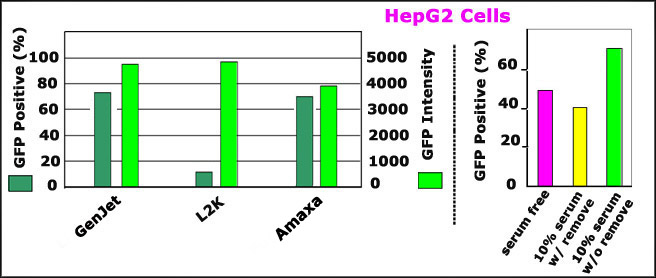EGFIE LLC
We always add value to our customers
Search by Keyword
Product Categories
GenJet™ DNA In Vitro Tranfection Reagent for HepG2 Cells is pre-optimized for HepG2 cell transfection. HepG2 (Hepatocellular carcinoma, human) is a perpetual add cell line which was derived from the liver tissue of a 15 year old caucasian male with a well differentiated hepatocellular carcinoma. These cells are epithelial in morphology, have a model chromosome number of 55 and are not tumorigenic in nude mice. The cells secrete a variety of major plasma proteins e.g.. albumin, alpha 2-macroglobulin, alpha 1-antitrypsin, transferrin and plasminogen. They have been grown successfully in large scale cultivation systems. Hepatitis B virus surface antigens have not been detected. HepG2 cells have been shown to be G418 resistant (400µg/mL). The cells will respond to stimulation with human growth hormone.
Refer to the following optimal transfection conditions for maximal transfection efficiency on HepG2 cells. GenJet™ reagent, 1.0 ml, is sufficient for 300 to 600 transfections in 24 well plates or 150 to 300 transfections in 6 well plates.
| Summary of Optimal Transfection Conditions: HepG2 cell culture Confluence on the day of transfection Cell culture conditions GenJet™ (µl) : DNA (µg) Ratio Diluent for DNA and Transfection Reagent Incubation Time to Form GenJet™/DNA Complex Presence of Serum/Antibiotics during Transfection Change Medium 5 Hours After Transfection Maximal Efficiency Transfection Results: Reporter Gene Plasmid Efficiency (GFP %) |
collagen type I pre-treated culture dish ~90% DMEM with 4.5 g/L glucose, 10% FBS 3:1 Serum-free DMEM with 4.5 g/L glucose 15 minutes at RT Yes No 48 hours EGFP pEGFP-N3 (CMV promoter) 82% |
Store at 4 °C. If stored properly, the product is stable for 12 months or longer
A Picture Showing Transfection Efficiency of GenJet™ Reagent on HepG2 Cells

GenJet™ reagent is optimized for HepG2 cells (ATCC # HB-8065) with exceptional efficiency in comparison of Lipofectamine 2000 (L2K) and Amaxa electroporation device. HepG2 cells were grown per ATCC recommended culture medium on a collagen type I treated culture dish and transfected with pEGFP-N3 by GenJet™. The efficiency was checked 48 hours post transfection.
Right Panel: Comparison of transfection efficiency of GenJet with Lipofecatmine 2000 (L2K), and Amaxa electroporation device on HepG2 cells. GFP DNA (pEGFP-N3, 4.7 kb) was introduced to HepG2 cell (cultured on Collagen pretreated dishes) with different transfection reagents per manufacturer's protocols . GFP positive cell (%) and fluorescence intensity were detected by passing through FACS 48 hours post transfection
Left Panel: presence of serum and antibiotics enhances GenJet reagent's efficiency on HepG2 cells. HepG2 cell (grown on collagen treated dishes) was transfected with three different conditions-------serum and antibiotics free, presence of 10% serum and antibiotics followed by removal 5 hours post transfection and presence of 10% serum and antibiotics without removal 5 hours post transfection.

GenJet™ reagent is optimized for HepG2 cells (ATCC # HB-8065). HepG2 cells were grown per ATCC recommended culture medium on a collagen type I treated culture dish and transfected with GFP (pEGFP-N3, 4.7 kb, right panel) and β-galactosidase cDNA (pSV-β-galactosidase, 6.9 kb, left panel) by pre-optimized GenJet™ DNA Transfection Reagent for HepG2 cells . The efficiency was checked 48 hours post transfection by Zeiss 510 Confocal Microscopy and β-galactosidase staining kit respectively.
Data Sheet
To request a free trial sample, please Create An Account with us to enter your shipping address and email us atorder@signagen.com

Testimonials
It has been tested and better results were obtained than with Amaxa Nucleofactor. A colleague and I, will be using it for all of our transfection experiments.
----------Fouad Francis., Ph.D., NICHD/NIH
I have got 70% efficiency with a GFP plasmid. With my protein of interest, which is 200KDa, I got 20% efficiency, pretty comparable to Amaxa electroporation. Thank you SignaGen.
--------Marina Uhart, Ph.D., NHLBI/NIH
Wow!!!!! What a product. We have been using Lipofectamine 2000 on HepG2 and have been struggling to get even modest transfection efficiency. In contrast, GenJet gave us dramatically higher transfection efficiency. By eye, looks like 5-10 fold improvement. The especially impressive part is that one uses less reagent and less DNA to get much better results. Our future HepG2 experiments will now all be done with GenJet. Thanks.
--------Erik Snapp, Ph.D., Albert Einstein College of Medicine.
Shopping Basket
| Items: | 0 |
| Subtotal: | $0.00 |
Note: All prices in US Dollars
customer@egfie.com